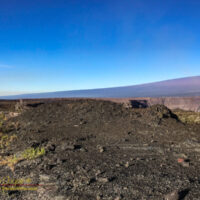Watching the current eruption at Kilauea where the western vent fountains and churns leaves one with a practical understanding of how a spatter cone or spatter rampart forms. The blobs and globs of lava land around the vent where they cool. This builds up a substantial edifice around the vent.
The process is illuminating to watch in this current eruption. Every few minutes a large spash or jet of lava escapes the boiling caldron in the middle. The lava spashes across the ground around the vent. At first bright orange, the splash slowly cools and fades to deep red, then dark at it solidifies. The spatter cone is just a little bit bigger.
The spatter cone grows and changes shape daily. Visiting the eruption after a couple weeks one finds the cone drastically reshaped and much larger. Occasional a side will collapse and the process begins anew.
While it might seem fun to get a closer look at the current vent, this idea is also a quick way to die, the gasses and heat would quickly kill anyone who approached too closely.
No need to risk death… It is possible to get a close look at a number of spatter cones around the park that are finished hurling blobs of death about One of these is only a few hundred yards from the Keanakako’i Overlook.
When you finish watching the current spatter cone grow you can check out a similar cone from the 1974 eruption nearby. Instead of turning left at the road to walk back to the car, turn right and walk another couple hundred yards. Perched on the caldera side of the road is a small spatter cone.
This unassuming mound may not attract much attention at first, look closer. Standing beside it one can see the fissure down the middle where the lava fountained, and see the structure made of overlapping cooled blobs of lava.
There are several others that are easily accessible. A large fissure and associated spatter ramparts is easily visited near the trailhead at Mauna Ulu a bit further down Chain of Craters Road. Instead of bearing to the left down the trail, follow the signs to the right where you will find the head of the 1969 lava flow and the fissure it erupted from. This is one of my favorite spots in the park as the fissure and quite a few other classic eruption features create a surreal landscape.
My favorite set of spatter ramparts is now inaccessible. A large fissure with a substantial set of spatter cones is in the center of the caldera right alongside the Halemaʻumaʻu trail. These are part of the 1982 caldera floor eruption. While much of that trail and the trailhead at the Halemaʻumaʻu parking lot is now gone, collaped into the crater with much of the caldera floor in 2018, it appears some of the spatter ramparts have survived, if a bit difficult to explore today.



